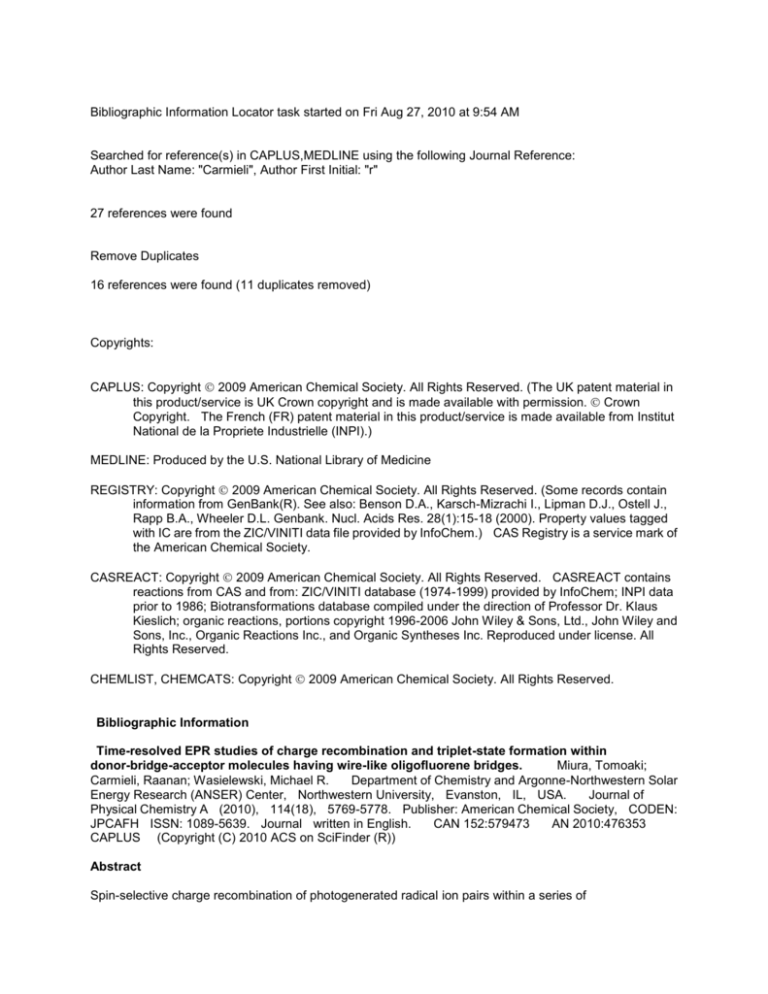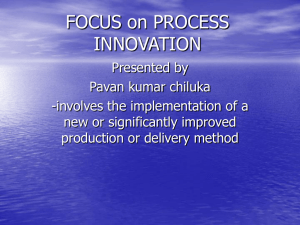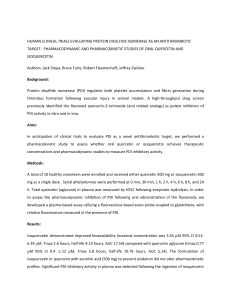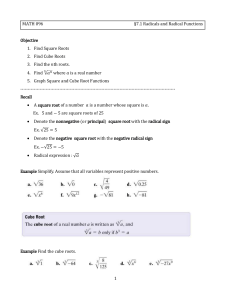
Bibliographic Information Locator task started on Fri Aug 27, 2010 at 9:54 AM
Searched for reference(s) in CAPLUS,MEDLINE using the following Journal Reference:
Author Last Name: "Carmieli", Author First Initial: "r"
27 references were found
Remove Duplicates
16 references were found (11 duplicates removed)
Copyrights:
CAPLUS: Copyright 2009 American Chemical Society. All Rights Reserved. (The UK patent material in
this product/service is UK Crown copyright and is made available with permission. Crown
Copyright. The French (FR) patent material in this product/service is made available from Institut
National de la Propriete Industrielle (INPI).)
MEDLINE: Produced by the U.S. National Library of Medicine
REGISTRY: Copyright 2009 American Chemical Society. All Rights Reserved. (Some records contain
information from GenBank(R). See also: Benson D.A., Karsch-Mizrachi I., Lipman D.J., Ostell J.,
Rapp B.A., Wheeler D.L. Genbank. Nucl. Acids Res. 28(1):15-18 (2000). Property values tagged
with IC are from the ZIC/VINITI data file provided by InfoChem.) CAS Registry is a service mark of
the American Chemical Society.
CASREACT: Copyright 2009 American Chemical Society. All Rights Reserved. CASREACT contains
reactions from CAS and from: ZIC/VINITI database (1974-1999) provided by InfoChem; INPI data
prior to 1986; Biotransformations database compiled under the direction of Professor Dr. Klaus
Kieslich; organic reactions, portions copyright 1996-2006 John Wiley & Sons, Ltd., John Wiley and
Sons, Inc., Organic Reactions Inc., and Organic Syntheses Inc. Reproduced under license. All
Rights Reserved.
CHEMLIST, CHEMCATS: Copyright 2009 American Chemical Society. All Rights Reserved.
Bibliographic Information
Time-resolved EPR studies of charge recombination and triplet-state formation within
donor-bridge-acceptor molecules having wire-like oligofluorene bridges.
Miura, Tomoaki;
Carmieli, Raanan; Wasielewski, Michael R.
Department of Chemistry and Argonne-Northwestern Solar
Energy Research (ANSER) Center, Northwestern University, Evanston, IL, USA.
Journal of
Physical Chemistry A (2010), 114(18), 5769-5778. Publisher: American Chemical Society, CODEN:
JPCAFH ISSN: 1089-5639. Journal written in English.
CAN 152:579473
AN 2010:476353
CAPLUS (Copyright (C) 2010 ACS on SciFinder (R))
Abstract
Spin-selective charge recombination of photogenerated radical ion pairs within a series of
donor-bridge-acceptor (D-B-A) mols., where D = phenothiazine (PTZ), B = oligo(2,7-fluorenyl), and A =
perylene-3,4:9,10-bis(dicarboximide) (PDI), PTZ-FLn-PDI, where n = 1-4 (compds. 1-4), is studied using
time-resolved ESR (TREPR) spectroscopy in which the microwave source is either continuous-wave or
pulsed. Radical ion pair TREPR spectra are obsd. for 3 and 4 at 90-294 K, while the neutral triplet state of
PDI (3*PDI) is obsd. at 90-294 K for 2-4 and at 90 K for 1. 3*PDI is produced by three mechanisms, as
elucidated by its zero-field splitting parameters and spin polarization pattern. The mechanisms are
spin-orbit-induced intersystem crossing (SO-ISC) in PDI aggregates, direct spin-orbit charge-transfer
intersystem crossing (SOCT) from the singlet radical pair within 1, and radical pair intersystem crossing
(RP-ISC) as a result of S-T0 mixing of the radical ion pair states in 2-4. The temp. dependence of the
spin-spin exchange interaction (2J) shows a dramatic decrease at low temps., indicating that the electronic
coupling between the radical ions decreases due to an increase in the av. fluorene-fluorene dihedral angle
at low temps. The charge recombination rates for 3 and 4 decrease at low temp., but that for 2 is almost
temp.-independent. These results strongly suggest that the dominant mechanism of charge
recombination for n 3 is incoherent thermal hopping, which results in wire-like charge transfer.
Bibliographic Information
Bioinspired charge and spin transport in donor-bridge-acceptor systems with conjugated
molecular bridges.
Scott, Amy M.; Butler Ricks, Annie; Dance, Zachary E. X.; Carmieli, Raanan;
Colvin, Michael T.; Giacobbe, Emilie; Wasielewski, Michael R.
Department of Chemistry and
Argonne-Northwestern Solar Energy Research (ANSER) Center, Northwestern University, Evanston,
IL, USA.
Abstracts of Papers, 238th ACS National Meeting, Washington, DC, United States, August
16-20, 2009 (2009),
PHYS-082. Publisher: American Chemical Society, Washington, D. C
CODEN: 69LVCL Conference; Meeting Abstract; Computer Optical Disk
AN 2009:986688
CAPLUS (Copyright (C) 2010 ACS on SciFinder (R))
Abstract
The efficient, multistep electron transfer pathway in photosynthesis that converts photon energy to chem.
energy has inspired the design of org. donor-bridge-acceptor (DBA) systems to undergo controlled energy,
charge, and spin transport for sustainable energy utilization. A series of p-oligophenylene (Phn),
p-oligophenyleneethynylene(PEn), and fluorenone (FNn) linked DBA triads covalently attached to a donor,
3,5,-dimethyl-4-(9-anthracenyl)-julolidine (DMJ-An) and an acceptor, naphthalene
-1,8:4,5-bis(dicarboximide) (NI) (Figure) exhibit superexchange mediated charge transport in cases with
large injection energy barriers, Phn and PEn series, and a hopping mechanism for charge sepn. in the FN
series. Nanosecond transient absorption spectra reveals 3*An and 3*NI spectroscopic signatures and
ESR (EPR) for Phn show a preference for hole transfer over electron transfer for radical ion pair
recombination. The measured exchange interaction, 2J, from magnetic field effect expts. decrease as a
function of bridge length and serves as a sensitive probe for elucidating the charge transport dependence
on mol. structure.
Bibliographic Information
Photodriven charge separation and transport in self-assembled donor-acceptor building blocks
for artificial photosynthesis.
Bullock, Joseph E.; Carmieli, Raanan; Mickley, Sarah M.; Vura-Weis,
Josh; Wasielewski, Michael R.
Department of Chemistry and Argonne-Northwestern Solar Energy
Research (ANSER) Center, Northwestern University, Evanston, IL, USA.
Abstracts of Papers,
238th ACS National Meeting, Washington, DC, United States, August 16-20, 2009 (2009),
PHYS-281. Publisher: American Chemical Society, Washington, D. C CODEN: 69LVCL Conference;
Meeting Abstract; Computer Optical Disk
AN 2009:986252
CAPLUS (Copyright (C) 2010 ACS on
SciFinder (R))
Abstract
We have prepd. a series of donor-acceptor triad building blocks (e.g. 1) consisting of a PDI acceptor, an
aminopyrene primary donor (APy), and a diaminobenzene secondary donor (DAB), which self-assemble
into helical hexamers (2) in soln. (SAXS, APS, Argonne). The PDI acceptors are pi-stacked with .apprx.35
deg dihedral angles, so that the DAB donors are not assocd. Time-resolved EPR spectroscopy places the
av. distance between the photogenerated radical ions within the hexamer at 30 .ANG., whereas the
through-bond DAB-PDI distance within the building block is only 24 .ANG.. The electrons migrate through
the PDI acceptor pi-stack faster than the 40 ns charge recombination time of DAB+--PDI--, and are trapped
at a PDI at the stack terminus. This result shows that nonbonded secondary charge transport within
ordered pi-stacked donors and/or acceptors can be kinetically competitive with charge recombination within
the covalent building block, an important design criterion for artificial photosynthetic systems.
Bibliographic Information
Photoinitiated Charge Transport through -Stacked Electron Conduits in Supramolecular
Ordered Assemblies of Donor-Acceptor Triads.
Bullock, Joseph E.; Carmieli, Raanan; Mickley,
Sarah M.; Vura-Weis, Josh; Wasielewski, Michael R.
Department of Chemistry and
Argonne-Northwestern Solar Energy Research (ANSER) Center, Northwestern University, Evanston,
IL, USA.
Journal of the American Chemical Society (2009), 131(33), 11919-11929. Publisher:
American Chemical Society, CODEN: JACSAT ISSN: 0002-7863. Journal written in English.
CAN
151:325310
AN 2009:930367
CAPLUS (Copyright (C) 2010 ACS on SciFinder (R))
Abstract
Photochem. electron donor-acceptor triads having an aminopyrene primary donor (APy) and a
p-diaminobenzene secondary donor (DAB) attached to either one or both imide nitrogen atoms of a
perylene-3,4:9,10-bis(dicarboximide) (PDI) electron acceptor were prepd. to give DAB-APy-PDI and
DAB-APy-PDI-APy-DAB. In toluene, both triads are monomeric, but in methylcyclohexane, they
self-assemble into ordered helical heptamers and hexamers, resp., in which the PDI mols. are -stacked in
a columnar fashion, as evidenced by small- and wide-angle x-ray scattering. Photoexcitation of these
supramol. assemblies results in rapid formation of DAB+-PDI- spin-polarized radical ion pairs having
spin-spin dipolar interactions, which show that the av. distance between the two radical ions is much larger
in the assemblies (31 .ANG.) than it is in their monomeric building blocks (23 .ANG.). This work
demonstrates that electron hopping through the -stacked PDI mols. is fast enough to compete effectively
with charge recombination (40 ns) in these systems, making these materials of interest as photoactive
assemblies for artificial photosynthesis and org. photovoltaics.
Bibliographic Information
Direct Measurement of Photoinduced Charge Separation Distances in Donor-Acceptor Systems
for Artificial Photosynthesis Using OOP-ESEEM.
Carmieli, Raanan; Mi, Qixi; Butler Ricks, Annie;
Giacobbe, Emilie M.; Mickley, Sarah M.; Wasielewski, Michael R.
Department of Chemistry and
Argonne-Northwestern Solar Energy Research-ANSER Center, Northwestern University, Evanston,
IL, USA.
Journal of the American Chemical Society (2009), 131(24), 8372-8373. Publisher:
American Chemical Society, CODEN: JACSAT ISSN: 0002-7863. Journal written in English.
CAN
151:111709
AN 2009:651590
CAPLUS (Copyright (C) 2010 ACS on SciFinder (R))
Abstract
Radical ion pair distance in several donor-acceptor artificial synthetic model systems was measured using
out-of-phase electron spin echo envelope modulation ( OOP-ESEEM). It is shown that OOP-ESEEM is
well-suited for probing the detailed structural features of charge-sepd. intermediates that are essential to
understanding how to design mol. structures that prolong and control charge sepn. for artificial
photosynthesis.
Bibliographic Information
Excited State, Charge Transfer, and Spin Dynamics in DNA Hairpin Conjugates with
Perylenediimide Hairpin Linkers.
Carmieli, Raanan; Zeidan, Tarek A.; Kelley, Richard F.; Mi, Qixi;
Lewis, Frederick D.; Wasielewski, Michael R.
Department of Chemistry and Argonne-Northwestern
Solar Energy Research (ANSER) Center, Northwestern University, Evanston, IL, USA.
Journal of
Physical Chemistry A (2009), 113(16), 4691-4700. Publisher: American Chemical Society, CODEN:
JPCAFH ISSN: 1089-5639. Journal written in English.
CAN 150:346916
AN 2009:226631
CAPLUS (Copyright (C) 2010 ACS on SciFinder (R))
Abstract
A series of short DNA hairpins (nG) using perylene-3,4:9,10-bis(dicarboximide) (PDI) as the hairpin linker
was synthesized in which the distance between the PDI and a guanine-cytosine (G-C) base pair is
systematically varied by changing the no. (n - 1) of adenine-thymine (A-T) base pairs between them. Due
to the relatively large hydrophobic surface of PDI, the nG hairpins dimerize in buffer solns. The
photophysics and photochem. of these hairpins were investigated using femtosecond transient absorption
and time-resolved ESR (TREPR) spectroscopy. Photoexcitation of the self-assembled PDI dimer within
each nG hairpin results in subpicosecond formation of its lower exciton state (1*PDI2) followed by formation
of an excimer-like state (1*XPDI2) with = 10-28 ps. Both of these states are lower in energy than 1*PDI,
so that neither can oxidize A, C, and T. Electron transfer from G to 1*PDI2 is faster than formation of
1*XPDI2 only for 1G. Electron transfer from G to 1*XPDI2 for 2G-8G, occurs by the superexchange
mechanism and thus, becomes exponentially less efficient as the G-PDI2 distance increases.
Nevertheless, TREPR studies show that photoexcitation of 2G and 4G produce spin-correlated radical ion
pairs having electron spin polarization patterns indicating that a low yield of charge sepn. proceeds from
1*XPDI2 by the radical pair intersystem crossing (RP-ISC) mechanism to initially yield a singlet radical ion
pair. The strong spin-polarization of the radical ion pairs makes it possible to observe them, even though
their concn. is low. As expected, the hairpin lacking G (0G) and that having the longest G-PDI2 distance
(8G) display no TREPR radical ion pair signals. Hairpins 0G, 2G, 4G, and 8G all exhibit triplet EPR spectra
at 85 K.
Simulations of the spectra show that 3*PDI is produced mainly by a spin-orbit-induced intersystem
crossing mechanism, while the spectra of 2G and 4G have 5% and 21% contributions, resp., from 3*PDI
produced by charge recombination of radical ion pairs that originate from RP-ISC. These low percentages
of RP-ISC derived 3*PDI result mainly from the low yield of radical ion pairs in 2G and 4G.
Bibliographic Information
Charge-Transfer and Spin Dynamics in DNA Hairpin Conjugates with Perylenediimide as a
Base-Pair Surrogate.
Zeidan, Tarek A.; Carmieli, Raanan; Kelley, Richard F.; Wilson, Thea M.;
Lewis, Frederick D.; Wasielewski, Michael R.
Department of Chemistry, Argonne-Northwestern Solar
Energy Research (ANSER) Center, Northwestern University, Evanston, IL, USA.
Journal of the
American Chemical Society (2008), 130(42), 13945-13955. Publisher: American Chemical Society,
CODEN: JACSAT ISSN: 0002-7863. Journal written in English.
CAN 149:488342
AN
2008:1154456
CAPLUS (Copyright (C) 2010 ACS on SciFinder (R))
Abstract
A perylenediimide chromophore (P) was incorporated into DNA hairpins as a base-pair surrogate to prevent
the self-aggregation of P that is typical when it is used as the hairpin linker. The photoinduced
charge-transfer and spin dynamics of these hairpins were studied using femtosecond transient absorption
spectroscopy and time-resolved EPR spectroscopy (TREPR). P is a photooxidant that is sufficiently
powerful to quant. inject holes into adjacent adenine (A) and guanine (G) nucleobases. The
charge-transfer dynamics obsd. following hole injection from P into the A-tract of the DNA hairpins is
consistent with formation of a polaron involving an estd. 3-4 A bases. Trapping of the (A3-4)+.bul. polaron
by a G base at the opposite end of the A-tract from P is competitive with charge recombination of the
polaron and P-.bul. only at short P-G distances. In a hairpin having 3 A-T base pairs between P and G
(4G), the radical ion pair that results from trapping of the hole by G is spin-correlated and displays TREPR
spectra at 295 and 85 K that are consistent with its formation from 1*P by the radical-pair intersystem
crossing mechanism. Charge recombination is spin-selective and produces 3*P, which at 85 K exhibits a
spin-polarized TREPR spectrum that is diagnostic of its origin from the spin-correlated radical ion pair.
Interestingly, in a hairpin having no G bases (0G), TREPR spectra at 85 K revealed a spin-correlated radical
pair with a dipolar interaction identical to that of 4G, implying that the A-base in the fourth A-T base pair
away from the P chromophore serves as a hole trap. Our data suggest that hole injection and transport in
these hairpins is completely dominated by polaron generation and movement to a trap site rather than by
superexchange. The barrier for charge injection from G+.bul. back onto the A-T base pairs is strongly
activated, so charge recombination from G (or even A trap sites at 85 K) most likely proceeds by a
superexchange mechanism.








